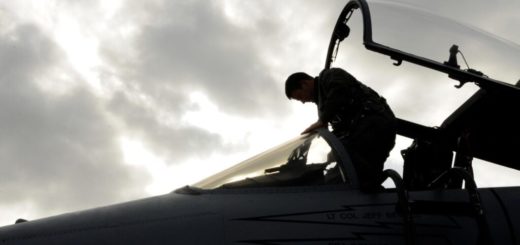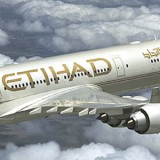Volotea CEO Carlos Muñoz, the man behind two successful European airlines

Few people in the airline industry can match the entrepreneurial record of Carlos Muñoz.
In just under a decade, Muñoz launched two of Europe’s most successful airlines. After the sale of his first success, Vueling, to Iberia (now part of the International Airlines Group), he launched Volotea in 2012, an innovative low-cost carrier connecting Europe’s small and mid-sized cities.
What’s more, Muñoz is a great communicator who does not shy away from expressing his views on a range of matters, from his early steps as an aviation entrepreneur to the key ingredients in the success of a low-cost airline venture.
Muñoz welcomed AeroTime at Volotea’s offices in central Barcelona for an hour-long conversation in which he revisited some of the key moments of his career, shared some valuable insights about his current venture, Volotea, and discussed some of the general trends shaping the European airline industry.
From oranges to aircraft
Remarkably for someone who has built two of Europe’s most successful airlines in such a short period of time, Muñoz was not involved in the airline industry until his thirties.
The scion of an agribusiness dynasty in southeastern Spain, Muñoz explained that from an early age he had always thought his career would ultimately gravitate towards the family business. However, a two-year stint studying for an MBA at Harvard Business School would drastically change this trajectory.
“There have been several generations of entrepreneurs in my family, so I guess I’ve got a bit of this in my DNA as well,” he said. “But it was in Boston, when I studied at Harvard in 1998, and then in California, working for McKinsey, that I started thinking about launching a business of my own. Five of my best mates at the MBA had already started their own companies and we were talking about this all the time.”
This, he said, is probably what gave him the entrepreneurial “bug”.
For some time, though, and while still pondering what sort of venture to launch, Muñoz started working at management consulting firm McKinsey. It was there while working on a consulting engagement, that Muñoz was given his first glimpse into the airline industry.
While Muñoz’s consulting work did not see him working with airlines as direct customers, “an assignment for a financial services firm involved a detailed assessment of the low-cost airline model”.
“This was the first time that I came across it and I got struck by its simplicity, its clarity and its transformational power,” he continued.
Launching Vueling
Even then, it would still take some time for the airline industry to feature in Muñoz’s plans. This would have to wait until late 2002, when a group of airline pilots came knocking on his door. By then, Muñoz was back in Spain working at a private equity firm in Madrid.
The pilots pitched him a project to launch a new carrier which would operate between Spain and the United Kingdom using Boeing 727 aircraft and, while Muñoz remained unconvinced about some aspects of the project, the idea piqued his curiosity.
After that first encounter, Muñoz said he could not stop thinking about the idea of starting a new airline, even during that year’s Christmas holiday, which he spent in California.
At the time, low-cost airlines were in their infancy in Europe. Ryanair and easyJet were already operating, and some other carriers had launched in Germany as well as several other countries, but without much to show for it at the time.
Altogether, this accounted for barely 7% of the market. What’s more, southwestern Europe (Spain, France, Portugal) was not particularly well served by this new breed of airlines. So, Muñoz spotted an opportunity.
In early January 2003, as soon as he landed back in Europe, Muñoz gathered the pilots and pressed them to invest together in the project. He even set up a firm, which he called Evia, an acronym for “European Ventures in Aviation”, the kernel of what would become Vueling. But, to his surprise, his counterparts got cold feet when the time came to make a move. He was on his own…but not for long.
Aware of the need to bring industry-specific expertise on board, Muñoz found a co-founder and investor in Lázaro Ros. Others would follow suit, such as venture fund Apax Partners, US airline JetBlue, and Planeta, a Barcelona-based media group.
The new airline finally launched in the summer of 2004, with what would soon become a household name: Vueling. The new airline soon began to gain traction, growing quickly, to the point that it was ready for an IPO less than two and a half years after its launch.
At that point, however, Spain’s flag carrier, Iberia, began to get restless and made some moves of its own. After an initial offer to acquire Vueling was rejected, Iberia launched its own Barcelona-based low-cost carrier, called Clickair. The new airline was to be a sort of “anti-Vueling”, tasked with neutralizing the new low-cost threat before it got too big.
With both airlines soon locked in a fierce price war, something had to give.
“They lost a lot of money and made us lose money as well,” Muñoz explained. “The situation ultimately led to the merger of the two companies.”
“Even if I opposed the merger at the time, the reality is that they did it pretty well. I was concerned that Vueling would just be swallowed into a larger group and disappear, but this hasn’t actually happened,” he added. “Vueling has since thrived and grown into a €3 billion a year business. What’s more, the brand has been preserved, as well as many aspects of its original culture.”
However, one consequence of Iberia’s acquisition of Vueling and its integration in the International Airlines Group (IAG) was Muñoz’s departure.
RELATED
Executive Spotlight: “We can go a long way.” Breeze Airways founder David Neeleman
Exit Vueling, enter Volotea
But Muñoz wasn’t out of the airline business for long. As soon as he left Vueling, he began plotting his next airline venture, a project that would eventually become Volotea.
It was not all plain sailing, though. Muñoz explained how, contrary to what tends to happen with second-time founders with a successful first exit, finding investors for his new airline venture proved to be a tough challenge. While it had taken just six months for Vueling to move from the idea stage to securing its first major investors, raising funds for Volotea took no less than two years, from 2009 to 2011.
Investors were finally found, led by CCMP, a US private equity fund and the new airline, Volotea, finally launched in April 2012.
Rather than facing the major low-cost carriers head on, this new venture was aimed at a relatively untapped market: directly connecting small- and medium-sized cities in Europe while bypassing the main hub airports.
Muñoz always avoids referring to Volotea as a “regional airline” because the term is commonly associated, particularly in the US, with an entirely different business model based on feeder airlines, which often enjoy little public recognition.
“We are neither a feeder, nor [do] we serve the large point to point markets as the large low-cost carriers do,” he said. “Volotea’s market opportunity was much less evident than the one we tackled with Vueling.”
He then turned to a stack of paper reports on one of the office shelves.
“Here is the data,” he said. “Nantes, Toulouse, Bordeaux, Lyon, Verona, Venice…these cities were all badly served.”
An opportunistic fleet choice
Besides the uniqueness of its business model, Volotea surprised many in the industry with its rather peculiar choice of aircraft: the Boeing 717. This aircraft type, of which only 156 have ever been built, was a legacy model designed by McDonnell Douglas before the latter was acquired by Boeing in 1997. By the time Volotea launched in 2012, though, the Boeing 717 was pretty much on its way out.
This provided Muñoz with a rather unique opportunity to acquire an aircraft of the right size for the job at advantageous prices.
“Southwest Airlines had just acquired AirTran [Airways] and found itself with a bunch of B717s that it had no use for. So, Boeing Capital, which was the actual owner of the aircraft, was interested in finding a new operator for them,” explained Muñoz. “It was a really quick negotiation, and we got really good terms.”
The B717 worked well for Volotea at first, but its small numbers soon became an obstacle for Volotea’s further expansion, particularly after Delta Air Lines cornered some of the last few available airframes to boost its own fleet.
At this point, Volotea began to switch to the Airbus A319 and, later, to larger A320s, which, as of April 2025, make up the majority of its fleet. The transition to an all-Airbus fleet was accelerated by the COVID-19 pandemic.
Choosing your niche wisely
But isn’t the A320 too large for the markets where Volotea operates?
“While we have increased the number of seats per aircraft to 168 on average across our fleet, if you look at the other operators, the likes of Wizz Air, Vueling or Ryanair, they have also been up-gauging heavily,” Muñoz explained. “So, the differential with them has gone down a bit, but not by that much. We had an average differential of around 50 seats per aircraft in the past and now is somewhere around 30.”
Markus Mainka / ShutterstockHere, Muñoz pointed out a curious fact, since Volotea started introducing larger aircraft, the overlap with other low-cost airlines has actually gone down.
“In terms of ASK [available seat kilometers] overlap, we are now at 6% with regards to Ryanair, and we had been at 12% in the past. This shows, in my opinion, how well positioned we are on those thin routes. Those small markets are certainly not off-limits to other operators, but we have become the specialists.”
Muñoz shared some figures to illustrate this point: while Volotea’s average route has 28,000 seats on offer, Ryanair and easyjet routes are in the 80,000 to 100,000 seat range on average and Vueling’s can be as high as 170,000.
According to Muñoz, the fact that Volotea’s growth has happened without really overlapping with other major European low-cost carriers, all while the latter were adding hundreds of aircraft and routes, shows the formidable development of the market in Europe over the last decade.
“We have the strong conviction, and this is not just a vision, it’s an idea backed by figures and analysis, that we are just getting started,” Muñoz said enthusiastically. “If we keep linking the dots across Europe, we could triple the number of routes we operate at the moment.”
But Volotea is not just expanding its geographical footprint, it is also growing by smoothing out seasonality in many of its current markets.
“At the very beginning, our activity was heavily concentrated in Q3. In our first year the three peak summer months represented 57% of our business. Even if this figure decreased a bit later on, between 2013 and 2018 it still represented 45 to 50% of our revenue, and we are now at 33%.” Muñoz explained. “We used to operate many of our routes for only three months a year at first but, as people started to get familiar with our services, we were able to extend those services to six or seven months in many cases and some are even year-round now.”
During the summer months Volotea uses the aircraft intensively, some for 12 hours per day, but the carrier shows no qualms about grounding aircraft whenever demand drops.
“You must get rid of the idea that the aircraft have to be flying all the time,” Muñoz added. “You don’t need to fly when it’s not profitable enough to do so.”
Here, Muñoz was referring to US airline Allegiant, which also has a marked seasonal traffic profile. Allegiant’s model, he said, provided some interesting lessons for Volotea.
“It’s a different way of thinking [about] the low-cost model. Some large operators prefer large, new planes because they are focused on bringing total costs down. Others, like us, are focused on the margin that each flight brings, so we prefer mid-sized, mid-life planes because, even if costs are low, if you fly the aircraft empty, margins are going to be negative,” he said. “With this model, you must have mid-life aircraft. It doesn’t make sense to pay top dollar for new aircraft if you are not going to have them flying all the time and year-round.”
Leisure traffic is still especially important to Volotea.
“It’s approximately 50%,” Muñoz said, going on to point out how VFR traffic [Visiting Friends and Relatives – ed. note] is now around 40%, particularly in places like France, where there is plenty of domestic mobility. For example, students going home and people with second homes. The remaining 10% is business traffic. Here, Volotea’s value proposition is clear – making it possible for small- and medium-sized businesses in smaller cities to skip cumbersome connections at big hubs.
Despite its marked singularities, Volotea shares some traits with other low-cost airlines, notably a product in which ancillary revenue plays a major role.
Muñoz, who put the share of ancillaries in Volote’s revenue “at around 40%”, is particularly proud of Megavolotea, the airline’s membership program, which allows regular travelers access to a number of ancillary services in exchange for an annual fee.
“Traditional low-cost carriers have quite a bad image in countries like France where we have a strong presence. There we have, instead, a positioning that people love. We are not pushing ancillaries aggressively; we don’t pressure passengers to buy ancillaries. In fact, half of our customers don’t buy any ancillary at all, they just purchase the ticket,” he said. “But we offer them the option to buy Megavolotea and, for those who fly regularly, it is a no-brainer. In many cases it pays off already with the first trip.”
RELATED
Executive Spotlight: “We are an airline of the future.” Wizz Air CEO, Jozsef Váradi
On the European competitive landscape
Muñoz also shared his thoughts about the competitive environment and the ongoing consolidation in the European airline industry.
“I am not surprised by the consolidation among Europe’s large airlines,” he said. “About the big groups swallowing medium-sized airlines like ITA, SAS, TAP…”
In fact, Volotea appeared on the sidelines of the recently frustrated merger between Iberia and Air Europa, Spain’s two largest airlines.
While not a party to that transaction, Volotea stood ready to step in case the European competition authorities had forced Iberia to divest from some of its activities at Madrid-Barajas Airport (MAD) as a condition to approve the merger. The plan contemplated Volotea going into a partnership with Abra Group, which owns Colombian airline Avianca as well as Spanish charter and ACMI operator Wamos, in order to create an alternative hub in Madrid.
Muñoz explained how, should it have gone ahead, the plan would have been quite consequential for the future of Volotea.
“It’s true that we would have deviated a bit from our core strategy. In some way this would have been like creating a ‘Volotea B’ within Volotea, but the opportunity was too good to pass,” he said. “We would have based some 20 aircraft in Madrid, and we would have worked with partners to feed that capacity. I can’t share all the details, but there was a plan.”
But the plan never went ahead. In August 2024, Iberia abandoned its project to acquire Air Europa following the serious objections expressed by the European Commission competition watchdog.
Muñoz further commented on the latest corporate moves in the airline sector.
“What surprises me a bit is that, so far, there hasn’t been more consolidation in the low-cost segment. There has been talk about it for a very long time. There were even rumors of Wizz Air being interested in acquiring easyJet, both have, actually, very complementary geographical networks.”
Could Volotea be part of any such consolidation move?
“We are in a different market altogether. We prefer to be the head of the mouse rather than the tail of a lion,” replied Muñoz. “We like to be the leader in our markets, and we don’t compete head on with many other airlines, particularly the legacy ones. We don’t go into their main hubs, we don’t go much into Madrid or Frankfurt, etc. We have a collaborative attitude.”
Muñoz pointed out how Volotea’s network is complementary to that of some of the legacy airlines and how this has facilitated a couple of strategic partnerships.
In Germany, Volotea has a commercial cooperation agreement with Lufthansa’s subsidiary Eurowings to cross-sell tickets on their respective networks. And in Greece, another of Volotea’s major markets, local champion Aegean Airlines, has emerged as a strategic partner for the airline and not just on the operational front.
In September 2024, Aegean Airlines became a shareholder in Volotea after providing half the capital in the Spanish airline’s latest funding round. The deal took the form of a €50 million convertible loan which will likely see Aegean Airlines take a 17% equity stake in Volotea.
“This is working very well, we are very complementary, and I would not rule out that we strengthen our links,” said Muñoz, who also highlighted the importance of the Greek market for Volotea.
What’s next for Volotea?
Is Volotea planning to expand its geographical reach and add new countries to its route map? While Muñoz did not rule out adding new markets opportunistically, he was clear on this point.
“Our core markets are Spain, France, and Italy, as well as Greece where we work together with Aegean Airlines and Germany, where we do so with Eurowings. We also have some presence in other places, like north Africa, in Morocco, Algeria…but we still have some way to go in our core markets, in terms of new routes and bases. I think that in the next five years we’ll be still be focusing our growth on our core geographies.”
A lingering matter is the IPO, which has long been on the cards. It was first talked about over a decade ago, but the listing has been called off repeatedly in that time.
“Technically we are IPO-ready. We have got the banks lined up, have talked investors…but we are waiting for the right moment,” Muñoz said. “If the market is bullish and responds well to big IPOs, then smaller companies will have better chances to IPO as well.”
When it comes to the future of the fleet, Muñoz confirmed the continued fleet up-gauging, with the A320 progressively replacing the few remaining A319s.
“We generally like the A320 better and, in fact, the A319s are only used in some 10 markets which all have some particularity, be it a PSO [Public Service Obligation – ed. note], some runway constraint, like in Florence (FLR), or because it is the Airbus shuttle [Volotea was selected in 2019 to operate the air service that links Airbus’ different facilities across Europe – ed. note].”
Overall, Muñoz is optimistic about the future, although he expects growth to slow down a bit in 2025.
“I am not for growth for the sake of growth,” he said. “We will grow if it is profitable and sustainable to do so. With the current conditions in the aircraft procurement market, we’ll not be adding much capacity. How fast can this situation change? I don’t know. If the aircraft market cools down, obviously we’ll add more planes faster than if it doesn’t.”
“Our activity is now double what it was in 2019,” he added. “And our five-year vision is to double again in size.”
Volotea has also been active in a number of sustainability initiatives, including a direct investment in a Spanish-Australian startup called Dovetail Electric Aviation, which is developing propulsion systems for electric aircraft.
However, Muñoz sees Sustainable Aviation Fuel (SAF) as the only realistic option to decarbonize aviation in the short term.
“SAF production is ramping up and we have not had issues with securing the supply necessary to meet the most immediate mandates. In the longer-term SAF production must go up, though, I think we can all agree on that,” he said. The post Volotea CEO Carlos Muñoz, the man behind two successful European airlines appeared first on AeroTime.
Few people in the airline industry can match the entrepreneurial record of Carlos Muñoz. In just under a…
The post Volotea CEO Carlos Muñoz, the man behind two successful European airlines appeared first on AeroTime.






